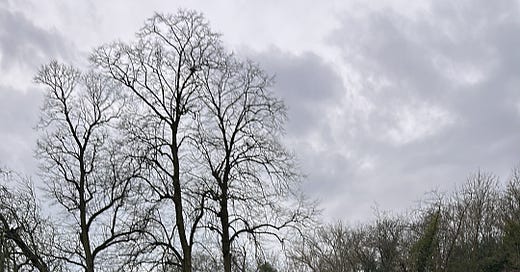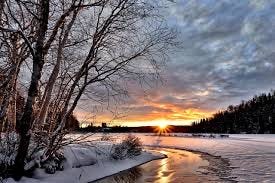Mais vous, Yver, trop estes plain De neige, vent, pluye et grezil ; On vous deust bannir en exil. Sans point flater, je parle plain, Yver, vous n'estes qu'un villain. Charles, Duc d’Orleans - c. 1431
January. It’s dark. It is too full of wind, rain and gray though not, alas, proper snow.
Technically, the days are lengthening, the nights shortening, but it doesn’t feel like it. In fact, somehow both things are true. The light is slowly stealing back, but—oddest thing—it’s happening mostly at sunset, not sunrise, at least until 9 January. The days are stretching more at one end than the other. This curious astrophysical and horological quirk is fitting for a month as peculiar as January.
Apparently, this phenomenon is to the “equation of time” which I just learned about and am now delighted to oversimplify for you. It’s the result of a complicated choreography between “solar time” and “clock time”. Solar time is the real thing: the time measured by the Earth’s actual position relative to the Sun. It is influenced by the tilt of the Earth’s axis, the fact that the orbit is an ellipse (not a perfect circle), and the Sun’s own imperfect movement in space. It’s not as tidy as a spinning gear on an astrolabe—it’s two celestial bodies spinning, tilting, and hurtling through space together in a cosmic wobble.
Clock time is the sanitised version. It’s a mean measurement of what time would be if the Earth moved in a perfectly consistent way. It gives us the neat, predictable 24-hour day with noon and midnight conveniently fixed. Solar time shifts. At this time of year, with the Northern Hemisphere tilted toward the Sun, the Earth is spinning faster than clock time such that, apparently, sunrise stays static for a few days while sunset edges forward—one of those odd things that remind you how messy and marvellous the universe is.
This mismatch certainly adds to the bleakness of January mornings. It’s hard to find poetry here in this dour grip, especially when the frost is absent and flattened by cold, drizzling rain and cold, whipping wind.
Even the twilight has abandoned us. At this time of year, twilight is shorter. That soft, peachy light that makes summer evenings glow disappears almost as soon as it arrives.
Twilight itself (I have learnt and eagerly share) comes in three phases, depending on the Sun’s position below the horizon:
• Civil twilight: when the Sun is up to six degrees below the horizon, giving just enough light to distinguish your surroundings.
• Nautical twilight: from six to twelve degrees below, when sailors can still navigate by the horizon and stars.
• Astronomical twilight: between twelve and eighteen degrees, when the Sun’s glow finally fades entirely.
In early January, the Sun zips through these phases, leaving us with little time to enjoy the magical transition from day to night. It’s bleak. It’s cold. It’s dark. But perhaps that’s the point.
Winter traditions like the Feast of Sol Invictus, Candlemas, Christmas, Epiphany, and Wassailing weren’t designed for sunny days and short shadows. They were meant to pull our focus from the dark, icy now toward the promise of the light and the future. They remind us to hold on.
I was reminded of this the other day on a run through Enfield Park. The grass was matted in that crystalline, crunchy frost that lends a dignity drizzle does not. I always run along the river, home to a family of ducks I like to think of as my friends, despite their pointed indifference to my quacking. That morning, the river was frozen, and a round-eyed adolescent gull was tapping at the ice, clearly amused by this unfamiliar barrier to the flowing stream below and taken aback by his own reflection.
There’s January right there. We’re stuck tapping at the ice, wanting the stream to come back. Perhaps, like the gull, we need to learn to enjoy a bit of tapping before we break through. The sun will tilt. The twilight and the stream will be ours again. We can ban winter into exile. But not just yet.






